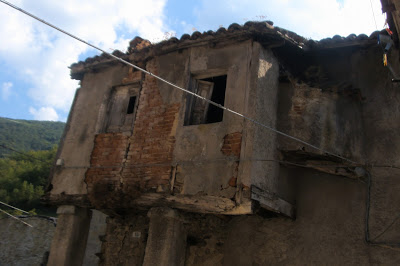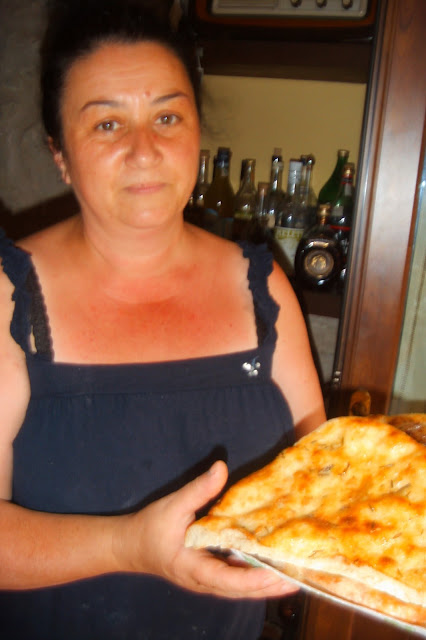This is a story
of neverending life, or, if you prefer, of the renewal of Life
In the summer
2013 we were driving almost at random, at the discovery of the hidden and
little secrets of our Country. We were in the region Marche. Driving along unwinding roads up in
the mountains beteween Marche and Umbria. We arrived in a narrow valley where two tiny villages climbing on the slopes
are facing one other.
The names of the villages are Pito and Umito: groups of
houses built with stones and wood, many of them blackened and semi-destroyed by
the Germanic submachines of the Second
World War.
How many people still live there? I bet no more than one
hundred in total. With the modern comfort of parabolic antennas to see all tv
channels, cars to go to the main town down to shop at the supermarket, and all
the technologies we are used to.
All that modernity lives together, for example, the common fountain where some women go to do their laundry.
I decided
to approach those women and talk with them. There is always something to learn. They have, of course
washing and drying machines, but sometimes, when the weather is nice and when
they have some particular cloth to wash, they go to the fountain: they find again
the lost habit of a chat on the last gossip with the others, they find the pleasure
to refresh themselves with the crispy mountain wáter and, you know what? Laundry
done with clear water just coming out from a crack in the rock and the smell of
the sun on the cloth when you hung it outside, is another story.
One of these women,
whose name is Lucrezia, took us to her house. We were curious to see the bread
she had just made that morning.
She showed us the wood fed oven in the garden,
with the wooden shoven to put the bread in
and out. She took us
inside. She took off the large table cloth covering a big pile on the
table.
The cloth was hiding and protecting a pile of bread
....and some
“schiacciainnanzi”, she said.
-
Schiacciainnanzi? What is it? - we asked.
-
It’s a flat bread that you put in the oven
before – that is “innanzi” – the bread to check if the temperature is right –
She gave us a schiacciainnanzi to taste. Delicious.
I asked how she makes the bread. The answer was simple, like
she was doing the most obvious thing in the world. Nothing fancy. Just normal life. She makes bread
once a week.
-
……and…it
lasts?-
-
Yes, it
is still good after one week. –
She distributes
the bread among all the members of her family, the married daughters and other relatives.
She kneads the dough by hand.
-
By hand?! All that dough? Isn’t it tiring? –
-
Yes, it is. But it is a habit, i have been doing
it since a little girl. And,
if I use the big mixing machine it seems to me that the dough doesn’t get the
same and then the bread tastes dfferent. –
She uses the flour milled at the close mill house. The wheat is cultivated by her brother:
-
…..
Just there, you see, right behind that small hill. –
-
How do
you rise it? Brewer yeast? –
-
No, I have the mother dough *) –
She took off a – smaller – cloth covering a glass jar over
the television.
The mother
dough was got in heritage by the mother, who had it from the grandmother, who
had it in turn by the great-grandmother. At least she knew this for
sure. But she thinks that that mother dough can be dated far and farer in the
past. My eyes were wide open. I
felt ignorant, overwhelmed and….happy.
Before
going away, she gave us a loaf of that
superb bread. We didn’t want to accept, as the gift looked too preciuos to be
given to unknown people like us. She insisted.
We greeted and left, proceeding our driving “at
random” toward the sea.
We decided
to lead to south. We crossed the region Abruzzi and arrived in Puglia.
We stopped – if i may say “stopped” as we constantly walk, drive, move – in
Puglia for a few days. Of course not enough to see, to understand, to live the
beauties of this region. We stopped in Otranto, Ostuni, Alberobello, Lecce.
One afternoon we decided to not go
in any restaurant for lunch. We bough some of the typical delicacies :
giuncata, salami, caciocavallo. We knew we had good tuscan wine in the tank of
the car, so we didn’t buy any.
We stopped in an olive trees park. We wanted to enjoy the company and
the teaching of those wise treees that were showing their history of their
millenian life through their twisted and contorted shapes.
We stopped at the shade of one of those and
we started to take out the food from the car and place it on a short stone
wall, one of those long stone walls that divide one property from one other in
Puglia.
Suddenly we realize: - we have forgotten to buy the
bread!!!! –
…. and we remembered that stupidly and un-gratefully we had - also forgotten the bread of Lucrezia in the
tank.
We took it
out, incredulous and sorry. How could it have happened?
Max took the bread out of the paper sack, slowly, with the
fear to discover a piece of stone or a mouldy crust. The loaf looked fine. He
pressed and cracked it under his fingers
with an appealing noise of crispiness. We tasted it. It was as perfect as it was just taken out from the oven. One week later!!! Forgotten in the
tank of the car under the sun of august!! Was that a miracle?
We had one of our
best meals of our life: perfect safe foods, home made wine with no added solphites,
miracle bread, fresh shade of wise trees telling their long stories. Just us, the
music of the crickets, the hot air rising up with undulating movements in the distance.













Comments
Post a Comment